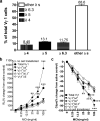Airway hyperresponsiveness through synergy of gammadelta} T cells and NKT cells
- PMID: 17709511
- PMCID: PMC4480876
- DOI: 10.4049/jimmunol.179.5.2961
Airway hyperresponsiveness through synergy of gammadelta} T cells and NKT cells
Abstract
Mice sensitized and challenged with OVA were used to investigate the role of innate T cells in the development of allergic airway hyperresponsiveness (AHR). AHR, but not eosinophilic airway inflammation, was induced in T cell-deficient mice by small numbers of cotransferred gammadelta T cells and invariant NKT cells, whereas either cell type alone was not effective. Only Vgamma1+Vdelta5+ gammadelta T cells enhanced AHR. Surprisingly, OVA-specific alphabeta T cells were not required, revealing a pathway of AHR development mediated entirely by innate T cells. The data suggest that lymphocytic synergism, which is key to the Ag-specific adaptive immune response, is also intrinsic to T cell-dependent innate responses.
Figures




Similar articles
-
Allergic airway hyperresponsiveness-enhancing gammadelta T cells develop in normal untreated mice and fail to produce IL-4/13, unlike Th2 and NKT cells.J Immunol. 2009 Feb 15;182(4):2002-10. doi: 10.4049/jimmunol.0803280. J Immunol. 2009. PMID: 19201853 Free PMC article.
-
Vgamma1+ T cells and tumor necrosis factor-alpha in ozone-induced airway hyperresponsiveness.Am J Respir Cell Mol Biol. 2009 Apr;40(4):454-63. doi: 10.1165/rcmb.2008-0346OC. Epub 2008 Oct 16. Am J Respir Cell Mol Biol. 2009. PMID: 18927346 Free PMC article.
-
gammadelta T cells contribute to the systemic immunoglobulin E response and local B-cell reactivity in allergic eosinophilic airway inflammation.Immunology. 2003 Jan;108(1):98-108. doi: 10.1046/j.1365-2567.2003.01561.x. Immunology. 2003. PMID: 12519308 Free PMC article.
-
Role of IgE in the development of allergic airway inflammation and airway hyperresponsiveness--a murine model.Allergy. 1999 Apr;54(4):297-305. doi: 10.1034/j.1398-9995.1999.00085.x. Allergy. 1999. PMID: 10371087 Review.
-
Anti-tumour immunotherapy with Vγ9Vδ2 T lymphocytes: from the bench to the bedside.Br J Haematol. 2013 Jan;160(2):123-32. doi: 10.1111/bjh.12090. Epub 2012 Oct 15. Br J Haematol. 2013. PMID: 23061882 Review.
Cited by
-
ICOS/ICOSL interaction is required for CD4+ invariant NKT cell function and homeostatic survival.J Immunol. 2008 Apr 15;180(8):5448-56. doi: 10.4049/jimmunol.180.8.5448. J Immunol. 2008. PMID: 18390727 Free PMC article.
-
Alternative spliced CD1d transcripts in human bronchial epithelial cells.PLoS One. 2011;6(8):e22726. doi: 10.1371/journal.pone.0022726. Epub 2011 Aug 11. PLoS One. 2011. PMID: 21853044 Free PMC article.
-
Aligning mouse models of asthma to human endotypes of disease.Respirology. 2014 Aug;19(6):823-33. doi: 10.1111/resp.12315. Epub 2014 May 9. Respirology. 2014. PMID: 24811131 Free PMC article. Review.
-
A novel role for NKT cells in cutaneous wound repair.J Surg Res. 2011 Jun 15;168(2):325-33.e1. doi: 10.1016/j.jss.2009.09.030. Epub 2009 Oct 9. J Surg Res. 2011. PMID: 20089261 Free PMC article.
-
Evidence that CD8+ dendritic cells enable the development of gammadelta T cells that modulate airway hyperresponsiveness.J Immunol. 2008 Jul 1;181(1):309-19. doi: 10.4049/jimmunol.181.1.309. J Immunol. 2008. PMID: 18566396 Free PMC article.
References
-
- Claman HN, Chaperon EA, Triplett RF. Immunocompetence of transferred thymus-marrow cell combinations. J. Immunol. 1966;97:828–832. - PubMed
-
- Castellino F, Huang AY, Altan-Bonnet G, Stoll S, Scheinecker C, Germain RN. Chemokines enhance immunity by guiding naive CD8+ T cells to sites of CD4+ T cell-dendritic cell interaction. Nature. 2006;440:890–895. - PubMed
-
- Wills-Karp M. Immunologic basis of antigen-induced airway hyperresponsiveness. Annu. Rev. Immunol. 1999;17:255–281. - PubMed
-
- Robinson DS, Hamid O, Ying S, Tsicopoulos A, Barkans J, Bentley AM, Corrigan C, Durham SR, Kay AB. Predominant TH2-like bronchoalveolar T-lymphocyte population in atopic asthma. N. Engl. J. Med. 1992;326:298–304. - PubMed
Publication types
MeSH terms
Substances
Grants and funding
- P01 HL036577/HL/NHLBI NIH HHS/United States
- R01 AI044920/AI/NIAID NIH HHS/United States
- HL 61005/HL/NHLBI NIH HHS/United States
- HL 36577/HL/NHLBI NIH HHS/United States
- AI 44920/AI/NIAID NIH HHS/United States
- HL 65410/HL/NHLBI NIH HHS/United States
- R21 AI063400/AI/NIAID NIH HHS/United States
- AI 40611/AI/NIAID NIH HHS/United States
- R01 HL061005/HL/NHLBI NIH HHS/United States
- R01 HL065410/HL/NHLBI NIH HHS/United States
- AI 063400/AI/NIAID NIH HHS/United States
- R01 AI057485/AI/NIAID NIH HHS/United States
- R01 AI040611/AI/NIAID NIH HHS/United States
- AI 057485/AI/NIAID NIH HHS/United States
LinkOut - more resources
Full Text Sources
Other Literature Sources

